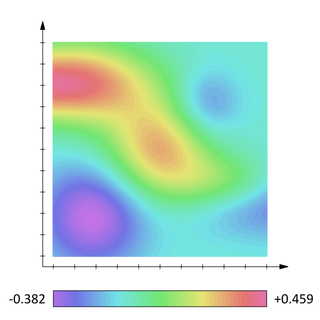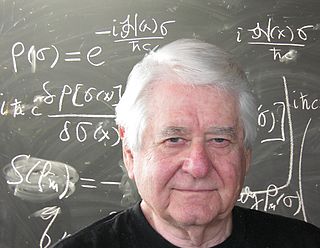Related Research Articles

General relativity, also known as the general theory of relativity and Einstein's theory of gravity, is the geometric theory of gravitation published by Albert Einstein in 1915 and is the current description of gravitation in modern physics. General relativity generalizes special relativity and refines Newton's law of universal gravitation, providing a unified description of gravity as a geometric property of space and time or four-dimensional spacetime. In particular, the curvature of spacetime is directly related to the energy and momentum of whatever matter and radiation are present. The relation is specified by the Einstein field equations, a system of second order partial differential equations.

In mathematics and physics, a scalar field is a function associating a single number to every point in a space – possibly physical space. The scalar may either be a pure mathematical number (dimensionless) or a scalar physical quantity.

The rotation curve of a disc galaxy is a plot of the orbital speeds of visible stars or gas in that galaxy versus their radial distance from that galaxy's centre. It is typically rendered graphically as a plot, and the data observed from each side of a spiral galaxy are generally asymmetric, so that data from each side are averaged to create the curve. A significant discrepancy exists between the experimental curves observed, and a curve derived by applying gravity theory to the matter observed in a galaxy. Theories involving dark matter are the main postulated solutions to account for the variance.
The Kerr metric or Kerr geometry describes the geometry of empty spacetime around a rotating uncharged axially symmetric black hole with a quasispherical event horizon. The Kerr metric is an exact solution of the Einstein field equations of general relativity; these equations are highly non-linear, which makes exact solutions very difficult to find.
In theoretical physics, the Einstein–Cartan theory, also known as the Einstein–Cartan–Sciama–Kibble theory, is a classical theory of gravitation, one of several alternatives to general relativity. The theory was first proposed by Élie Cartan in 1922.
Teleparallelism, was an attempt by Albert Einstein to base a unified theory of electromagnetism and gravity on the mathematical structure of distant parallelism, also referred to as absolute or teleparallelism. In this theory, a spacetime is characterized by a curvature-free linear connection in conjunction with a metric tensor field, both defined in terms of a dynamical tetrad field.
Since the 19th century, some physicists, notably Albert Einstein, have attempted to develop a single theoretical framework that can account for all the fundamental forces of nature – a unified field theory. Classical unified field theories are attempts to create a unified field theory based on classical physics. In particular, unification of gravitation and electromagnetism was actively pursued by several physicists and mathematicians in the years between the two World Wars. This work spurred the purely mathematical development of differential geometry.
The Kerr–Newman metric is the most general asymptotically flat and stationary solution of the Einstein–Maxwell equations in general relativity that describes the spacetime geometry in the region surrounding an electrically charged and rotating mass. It generalizes the Kerr metric by taking into account the field energy of an electromagnetic field, in addition to describing rotation. It is one of a large number of various different electrovacuum solutions; that is, it is a solution to the Einstein–Maxwell equations that account for the field energy of an electromagnetic field. Such solutions do not include any electric charges other than that associated with the gravitational field, and are thus termed vacuum solutions.
In general relativity, the pp-wave spacetimes, or pp-waves for short, are an important family of exact solutions of Einstein's field equation. The term pp stands for plane-fronted waves with parallel propagation, and was introduced in 1962 by Jürgen Ehlers and Wolfgang Kundt.

John W. Moffat is a Canadian physicist. He is currently professor emeritus of physics at the University of Toronto and is also an adjunct professor of physics at the University of Waterloo and a resident affiliate member of the Perimeter Institute for Theoretical Physics.
Tensor–vector–scalar gravity (TeVeS), developed by Jacob Bekenstein in 2004, is a relativistic generalization of Mordehai Milgrom's Modified Newtonian dynamics (MOND) paradigm.
In theoretical physics, massive gravity is a theory of gravity that modifies general relativity by endowing the graviton with a nonzero mass. In the classical theory, this means that gravitational waves obey a massive wave equation and hence travel at speeds below the speed of light.
In theoretical physics, particularly fringe physics, polarizable vacuum (PV) and its associated theory refer to proposals by Harold Puthoff, Robert H. Dicke, and others to develop an analog of general relativity to describe gravity and its relationship to electromagnetism.
Scalar–tensor–vector gravity (STVG) is a modified theory of gravity developed by John Moffat, a researcher at the Perimeter Institute for Theoretical Physics in Waterloo, Ontario. The theory is also often referred to by the acronym MOG.
Alternatives to general relativity are physical theories that attempt to describe the phenomenon of gravitation in competition with Einstein's theory of general relativity. There have been many different attempts at constructing an ideal theory of gravity.

Gravitoelectromagnetism, abbreviated GEM, refers to a set of formal analogies between the equations for electromagnetism and relativistic gravitation; specifically: between Maxwell's field equations and an approximation, valid under certain conditions, to the Einstein field equations for general relativity. Gravitomagnetism is a widely used term referring specifically to the kinetic effects of gravity, in analogy to the magnetic effects of moving electric charge. The most common version of GEM is valid only far from isolated sources, and for slowly moving test particles.
Bumblebee models are effective field theories describing a vector field with a vacuum expectation value that spontaneously breaks Lorentz symmetry. A bumblebee model is the simplest case of a theory with spontaneous Lorentz symmetry breaking.

Reinventing Gravity: A Scientist Goes Beyond Einstein is a science text by John W. Moffat, which explains his controversial theory of gravity.
Bimetric gravity or bigravity refers to two different classes of theories. The first class of theories relies on modified mathematical theories of gravity in which two metric tensors are used instead of one. The second metric may be introduced at high energies, with the implication that the speed of light could be energy-dependent, enabling models with a variable speed of light.
Within general relativity (GR), Einstein's relativistic gravity, the gravitational field is described by the 10-component metric tensor. However, in Newtonian gravity, which is a limit of GR, the gravitational field is described by a single component Newtonian gravitational potential. This raises the question to identify the Newtonian potential within the metric, and to identify the physical interpretation of the remaining 9 fields.
References
- 1 2 J. W. Moffat (1995), "Nonsymmetric Gravitational Theory", Phys. Lett. B, 355 (3–4): 447–452, arXiv: gr-qc/9411006 , Bibcode:1995PhLB..355..447M, doi:10.1016/0370-2693(95)00670-G, S2CID 15879285
- ↑ J. W. Moffat (1979), "New theory of gravitation", Phys. Rev. D, 19 (12): 3554–3558, Bibcode:1979PhRvD..19.3554M, doi:10.1103/PhysRevD.19.3554
- ↑ S. Ragusa (1997), "Nonsymmetric Theory of Gravitation", Phys. Rev. D, 56 (2): 864–873, Bibcode:1997PhRvD..56..864R, doi:10.1103/PhysRevD.56.864
- ↑ Janssen, T.; Prokopec, T. (2007), "Problems and hopes in nonsymmetric gravity", J. Phys. A, 40 (25): 7067–7074, arXiv: gr-qc/0611005 , Bibcode:2007JPhA...40.7067J, doi:10.1088/1751-8113/40/25/S63, S2CID 6502419
- ↑ J. W. Moffat (2005), "Gravitational Theory, Galaxy Rotation Curves and Cosmology without Dark Matter", Journal of Cosmology and Astroparticle Physics, 2005 (5): 3, arXiv: astro-ph/0412195 , Bibcode:2005JCAP...05..003M, doi:10.1088/1475-7516/2005/05/003, S2CID 307531
- ↑ Richard T. Hammond (2013), "Spin from the Nonsymmetric Metric Tensor", International Journal of Modern Physics D, 22 (12): 1342009, Bibcode:2013IJMPD..2242009H, doi:10.1142/s0218271813420091